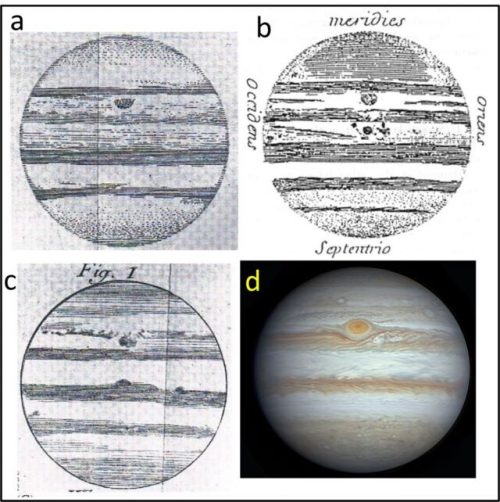Apparently, Jupiter’s red spot may be transient and repetitive, coming and going.
Sánchez-Lavega et al. concluded that the current Red Spot is probably not the same as that observed by Cassini and others in the 17th century. They argue that the Permanent Spot had faded by the start of the 18th century, and a new spot formed in the 19th century—the one we observe today, making it more than 190 years old.
Others remain unconvinced of that conclusion, such as astronomer Scott Bolton of the Southwest Research Institute in Texas. “What I think we may be seeing is not so much that the storm went away and then a new one came in almost the same place,” he told New Scientist. “It would be a very big coincidence to have it occur at the same exact latitude, or even a similar latitude. It could be that what we’re really watching is the evolution of the storm.”

Comparison between the Permanent Spot and the current Great Red Spot. (a) December 1690. (b) January 1691. (c) January 19, 1672. (d) August 10, 2023.
It would be such a bummer to plan a vacation to Jupiter and have a major tourist attraction evaporate, so NASA better get right on this mystery and give me a firm schedule for Red Spot fluctuations.


I just want to remark on the optical illusion in that image above. To me, the picture in the lower right seems to be endlessly receding into the distance every time I look away and look back.
It started with a lab leak! Can’t you all see?! WAKE UP, SHEEPLE!!!!
@drksky #1
I didn’t see that at first, but now I can’t not see it. : )
The thing is, RagingBee@2, we don’t actually know the origin of the GRS, so it’s best to keep an open mind.
When the Red Spot finally disappears, Southek the Destroyer will be free from his prison.
(Dr Who fans will know what I mean).
I thought I read somewhere that the storm Cassini saw was rotating in the opposite direction to the storm we see now. If that were true I would have to agree it’s a different spot, since as far as I know cyclones don’t just reverse direction without stopping first. And if it were a new spot appearing in the same location might not be a coincidence. Something about Jupiter’s makeup might just make big storms more likely at that latitude.
The figure is a little misleading.
I expanded the figure and screenshotted both top and bottom halves, then recombined them in Paint into a four disks side-by-side for comparison. Fig. A is a little larger than all of the others, Fig. B is the smallest. C and D are the same size, but are not aligned through the equator. D is visibly higher on the page than C.
Laying them all side-by-side and aligned at the equator, the spot appears (to me) to be in the same place in A, C, and D. It might be a touch lower in B, but that could be an effect of the image size difference (I didn’t resize them, since the difference isn’t visible until you try to line them up within the frame of the window and see that A overlaps the frame slightly, B is contained with a little whitespace around the edge, and C and D fit the edge almost exactly), or it could be that it was inaccurately sketched.
In any case, we’re talking about a difference of less than half the vertical width of the storm, here.
Besides, what’s to stop a giant storm from moving a “little” north or south over three and a half centuries? (“Little” is relative to the size of the planet, not on the scale we live with!)
Just my two cents.
Meanwhile, YouTube “philosophers” argue about the spot of Theseus.
Apparently the GRS is currently shrinking and getting taller too :
Source : https://science.nasa.gov/missions/hubble/jupiters-great-red-spot-getting-taller-as-it-shrinks-nasa-team-finds/
Its still greater and longer lasting than Neptune’s Great Dark Spot seen by Voyager 11 back in 1989 but which subsequently disappeared though.
For Neptune’s Great Dark Spot see :
https://www.britannica.com/place/Neptune-planet/Basic-astronomical-data#ref515033
Thinking major storms on gas giants there’s Saturn’s dragon storm :
https://science.nasa.gov/resource/spotting-saturns-northern-storm-2/
Plus outside our solar system we’ve seen hot spots on Hot Jupiters that would be really scalding & whoknows how long lasting here :
https://www.jpl.nasa.gov/images/pia13494-weird-warm-spot-on-exoplanet
Plus this one as well and more :
https://science.nasa.gov/missions/hubble/nasas-hubble-observes-exoplanet-atmosphere-changing-over-3-years/
(Upsilon Andromedae b & WASP-121 b respectively.) Amazing that we can observe the atmospheres of worlds so far away and so close to their stars.
I’ve been doing amateur astronomy for 30 years or better. The astronomer in the article is correct, the storm evolves. It changes in size and color. No big surprise.
It is possible it’s coming and going over longer spans than I’ve been observing though. But I’m not convinced yet.
1.None of those sketches appear to show that it disappeared entirely.
2. Seeing (an atmospheric condition that affects clarity,) and other factors such as haze, smoke (even if its source is 100’s of miles away,) can cause mushy views. Which can lead one to make one to reach an iffy observational conclusion, haven’t apparently, been ruled out.
3. Telescopes today, owned by rank amateurs outclass 17th century scopes by a magnitude or two.
4. I didn’t really see any large consensus in the article. other than “the team.”
5. Guess what? The spot isn’t always facing us either. One could mistakenly believe it had disappeared on any given night of observation…
Somebody convince me.